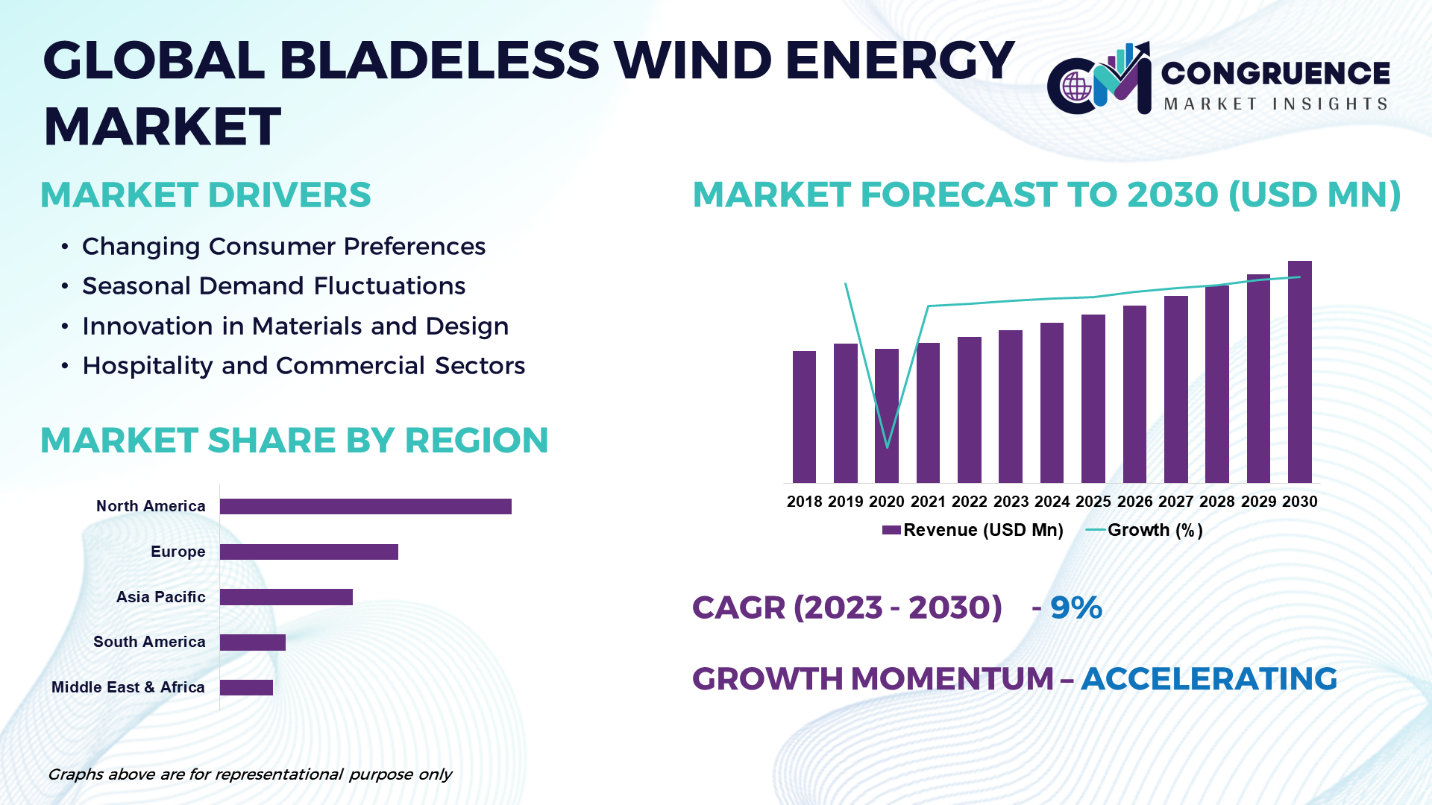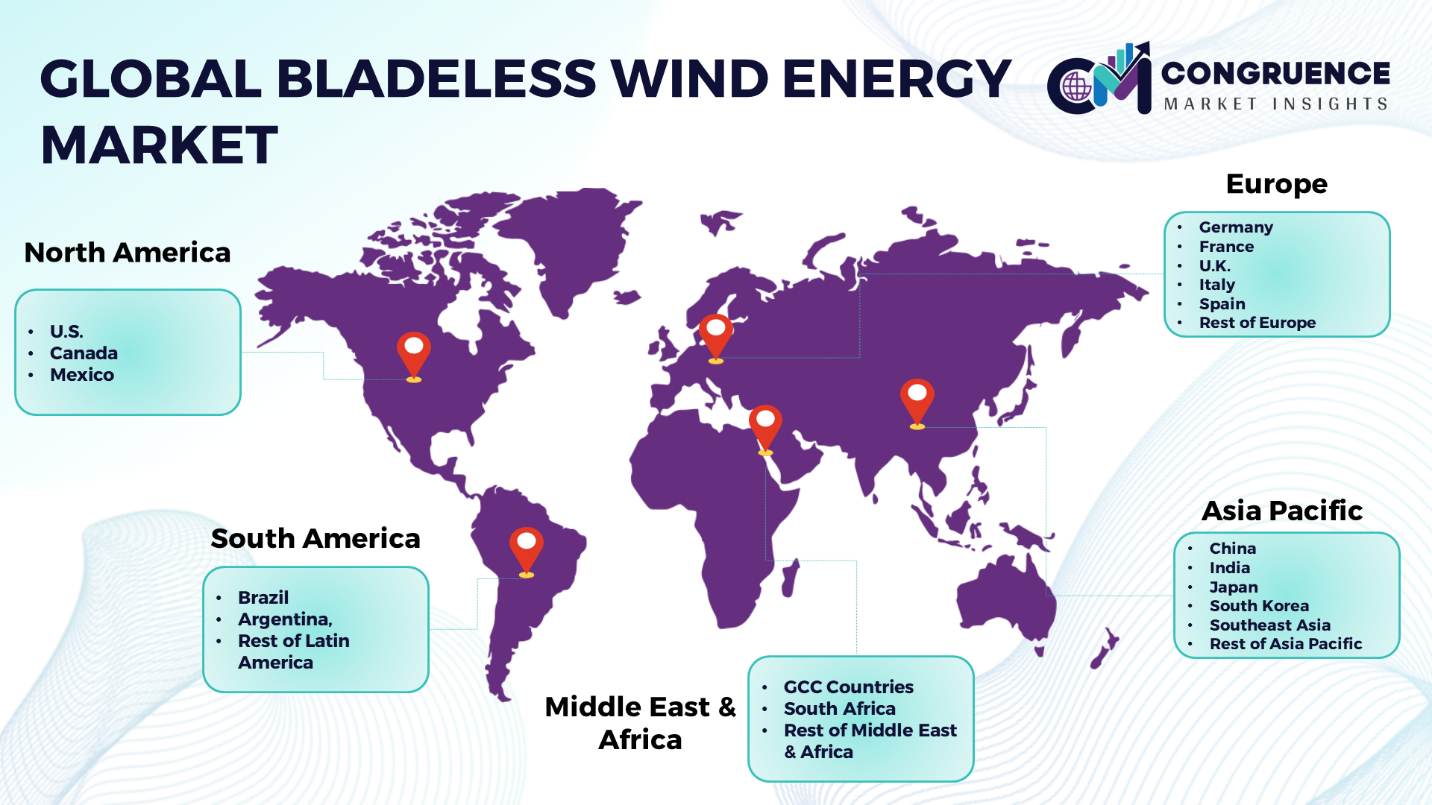Reports
The Global Bladeless Wind Energy Market is expected to expand at a CAGR of 9% between 2023 and 2030. Offering cutting-edge methods for capturing wind energy without the need for conventional turbine blades, the global bladeless wind energy market is a growing segment of the renewable energy industry. By reducing noise pollution, visual impact, and bird collisions, among other drawbacks and difficulties with traditional wind turbines, bladeless wind energy solutions also seek to increase cost- and energy-efficiency. Alternative processes, such oscillating foils, airfoil-shaped structures, or vortex-induced vibrations, are employed by bladeless wind energy systems to harvest wind flow kinetic energy and transform it into electrical power. These technologies provide various benefits, such as less maintenance requirements, fewer operating costs, and higher environmental friendliness, by doing away with the need for revolving blades. Bladeless wind energy solutions are becoming more and more popular due to a number of issues, such as the desire to improve energy security and diversify the energy mix, as well as the growing concern over climate change and air pollution. Bladeless wind energy systems are also attractive to stakeholders looking for creative and visually beautiful ways to replace conventional wind turbines, especially in residential and urban settings where visual impact and available space are important factors.

Bladeless Wind Energy Market Major Driving Forces
Environmental Compatibility and Noise Reduction: Since bladeless wind energy systems produce less noise than conventional wind turbines, they are appropriate for locations that are noisy, such as homes and wildlife habitats. Lower noise levels improve wind energy projects' environmental compatibility and social acceptability.
Conservation of Wildlife: Birds and bats are at risk of collisions with the rotating blades of traditional wind turbines. Since bladeless wind energy systems remove this risk, they are the best option for conservation efforts involving wildlife and delicate natural environments.
Technological Developments: The industry is expanding and becoming more widely used as a result of continuous developments in bladeless wind energy technology, which include gains in scalability, efficiency, and dependability. The market is expanding more quickly thanks to research and development initiatives aimed at improving the efficiency and affordability of bladeless wind energy systems.
Energy Security and Diversification: By offering a dependable and renewable electricity source, bladeless wind energy promotes energy security and diversification. Reducing reliance on imported energy sources and fossil fuels increases energy independence and resilience to supply shocks.
Bladeless Wind Energy Market Key Opportunities
Applications in Urban and Residential Environments: Due to space restrictions and concerns about visual impact, standard wind turbines are not viable in urban or residential environments. However, bladeless wind energy systems provide considerable potential for deployment in these situations. In order to produce renewable energy locally and support urban sustainability objectives, these systems can be integrated into the streetlights, noise barriers, and buildings that now make up the urban infrastructure.
Offshore Wind Energy: Whereas logistical difficulties and severe environmental conditions prevent conventional wind turbines from being installed offshore, bladeless wind energy technologies present encouraging prospects for offshore wind energy development. In order to address rising energy demand and lessen dependency on land-based renewable energy sources, offshore bladeless wind energy systems can be installed in remote areas and deeper waters.
Hybrid Renewable Energy Systems: Combining bladeless wind power with other renewable energy sources, such energy storage devices and solar photovoltaics (PV), presents a chance to create hybrid renewable energy systems that offer a dependable and robust power source. By optimizing energy production, delivery, and storage, hybrid systems can reduce dependency on traditional energy sources and maximize the use of renewable resources.
Bladeless Wind Energy Market Key Trends
· Continued innovation and R&D efforts are enhancing the efficiency, reliability, and scalability of bladeless wind energy systems.
· Increasing focus on integrating bladeless wind energy systems into urban landscapes to meet local energy needs and address aesthetic concerns.
· Growing interest in offshore deployment of bladeless wind energy systems to tap into vast wind resources and overcome land-based limitations.
· Rising adoption of hybrid renewable energy systems combining bladeless wind energy with solar PV, energy storage, and other technologies for optimized energy production.
· Global expansion of the bladeless wind energy market, driven by increasing demand for clean and sustainable energy solutions.
· Favorable government policies, incentives, and regulatory frameworks promoting renewable energy deployment, including bladeless wind technologies.
· Bladeless wind energy systems playing a crucial role in expanding energy access and rural electrification efforts in underserved communities.
· Growing adoption of bladeless wind energy systems by corporations seeking to reduce carbon footprint, enhance energy security, and demonstrate sustainability commitments.
· Recognition of the environmental benefits of bladeless wind energy, including reduced noise pollution, visual impact, and wildlife disturbance.
· Improvements in cost-effectiveness and ROI of bladeless wind energy systems, making them increasingly competitive with conventional wind turbines and fossil fuel-based energy sources.

Market Competition Landscape
The market for bladeless wind energy is very competitive, with both well-established businesses and creative startups vying for market share and technological advancements. With its innovative bladeless wind turbine design that is gaining attention for its potential to completely transform the industry, Vortex Bladeless stands out as a pioneer in the sector. Another well-known player is Saphon Energy, which is well-known for its ground-breaking Zero-Blade technology, which captures wind energy using a special sail-shaped structure. Using its experience in engineering and aerodynamics, reputable aerospace and defense business AeroVironment has introduced its unique vertical-axis wind turbine solutions to the bladeless wind energy market. With their unique approaches to bladeless wind energy technologies, ENESSERE, WindSail, and Green Ocean Energy are a few other noteworthy participants. These businesses work together on research and development projects to spur innovation and hasten the global adoption of bladeless wind energy, even as they compete to create the most effective and economical solutions. Competition is predicted to get more intense as the market develops, with new players and technological breakthroughs reshaping the competitive environment and spurring additional expansion and innovation in the sector. Leading players in the market include:
· Vortex Bladeless
· Saphon Energy
· AeroVironment
· ENESSERE
· WindSail
· Green Ocean Energy
· Nenuphar
· Alpha 311
· ARCA
· Hyperwind Technology
· Exro Technologies
· Magenn Power
· SheerWind
· Ropatec
· Quiet Revolution
|
Report Attribute/Metric |
Details |
|
Base Year |
2022 |
|
Forecast Period |
2023 – 2030 |
|
Historical Data |
2018 to 2022 |
|
Forecast Unit |
Value (US$ Mn) |
|
Key Report Deliverable |
Revenue Forecast, Growth Trends, Market Dynamics, Segmental Overview, Regional and Country-wise Analysis, Competition Landscape |
|
Segments Covered |
· By Project Type (Onshore, Offshore) · By Application (Urban Areas, Rural Areas, Industrial Facilities) · By End User (Commercial, Residential, Industrial, Government) |
|
Geographies Covered |
North America: U.S., Canada and Mexico Europe: Germany, France, U.K., Italy, Spain, and Rest of Europe Asia Pacific: China, India, Japan, South Korea, Southeast Asia, and Rest of Asia Pacific South America: Brazil, Argentina, and Rest of Latin America Middle East & Africa: GCC Countries, South Africa, and Rest of Middle East & Africa |
|
Key Players Analyzed |
Vortex Bladeless, Saphon Energy, AeroVironment, ENESSERE, WindSail, Green Ocean Energy, Nenuphar, Alpha 311, ARCA, Hyperwind Technology, Exro Technologies, Magenn Power, SheerWind, Ropatec, Quiet Revolution |
|
Customization & Pricing |
Available on Request (10% Customization is Free) |
